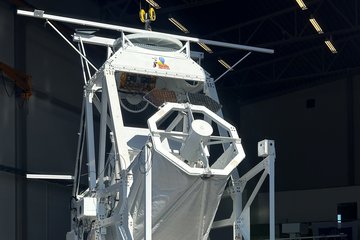All genres
1.
Journal Article
Correlations between Total and Spectral Solar Irradiance Variations. The Astrophysical Journal 964, p. 60 (2024)
2.
Journal Article
Correlations between Total and Spectral Solar Irradiance Variations. The Astrophysical Journal 964, p. 60 (2024)
3.
Journal Article
Forward modelling of brightness variations in Sun-like stars. II. Light curves and variability. Astronomy and Astrophysics 672, A138 (2023)
4.
Journal Article
Faculae Cancel out on the Surfaces of Active Suns. The Astrophysical Journal 934, p. L23 (2022)
5.
Journal Article
Predictions of Astrometric Jitter for Sun-like Stars. III. Fast Rotators. The Astrophysical Journal 934, p. 146 (2022)
6.
Journal Article
Predictions of Astrometric Jitter for Sun-like Stars. III. Fast Rotators. The Astrophysical Journal 934, p. 146 (2022)
7.
Journal Article
Where Have All the Solar-like Stars Gone? Rotation Period Detectability at Various Inclinations and Metallicities. The Astrophysical Journal Letters 908 (2), L21 (2021)
8.
Journal Article
Predictions of Astrometric Jitter for Sun-like Stars. II. Dependence on Inclination, Metallicity, and Active-region Nesting. The Astrophysical Journal 919 (2), 94 (2021)
9.
Journal Article
Predictions of Astrometric Jitter for Sun-like Stars. II. Dependence on Inclination, Metallicity, and Active-region Nesting. The Astrophysical Journal 919, p. 94 (2021)
10.
Journal Article
Modeling Stellar Ca ii H and K Emission Variations. I. Effect of Inclination on the S-index. The Astrophysical Journal 914 (1), 21 (2021)
11.
Journal Article
Modeling Stellar Ca II H and K Emission Variations. I. Effect of Inclination on the S-index. The Astrophysical Journal 914, p. 21 (2021)
12.
Journal Article
Stellar impact on disequilibrium chemistry and observed spectra of hot Jupiter atmospheres. Astronomy and Astrophysics 639, A48 (2020)
13.
Talk
Studying physics and chemistry in atmospheres of hot Jupiters from future ground-based and space facilities. Europlanet Science Congress 2020, online (2020)
14.
Talk
Solar brightness variations as they would be observed by the Kepler telescope. Observing the Sun as a star: Would we find the solar system if we saw it?, Göttingen, Germany (2018)
15.
Talk
Solar brightness variations as observed by the Kepler telescope. XXXth General Assembly of the International Astronomical Union, Vienna, Austria (2018)
16.
Poster
The XUV Sun in Time. XXXth General Assembly of the International Astronomical Union, Vienna, Austria (2018)











